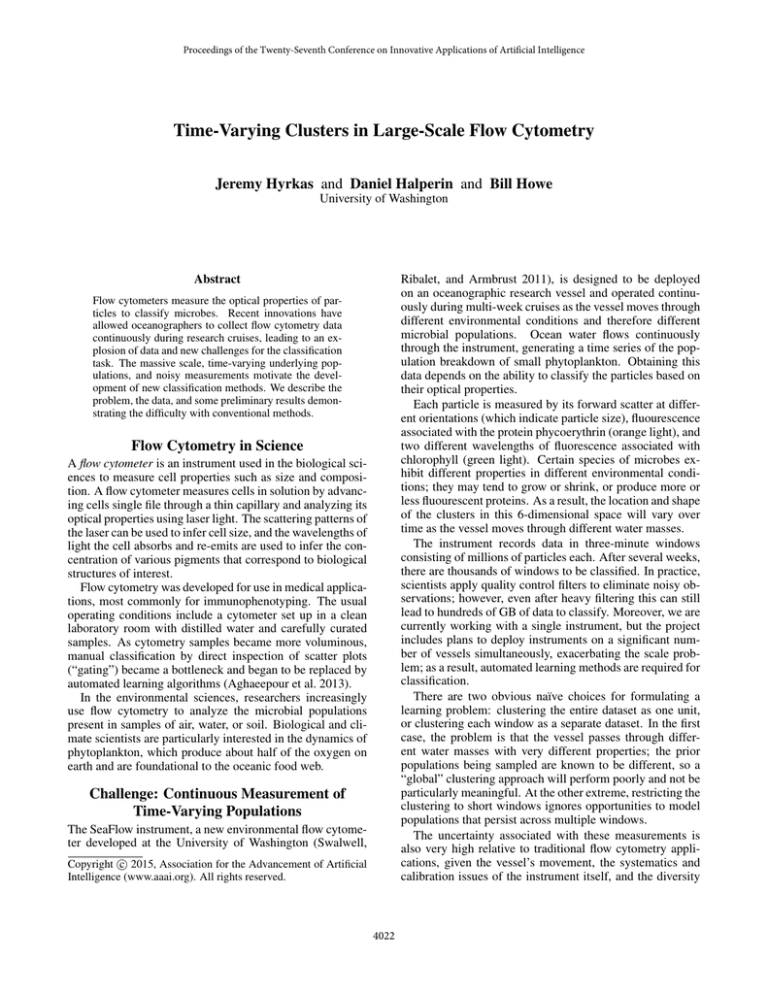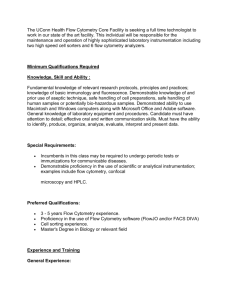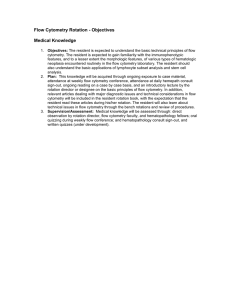
Proceedings of the Twenty-Seventh Conference on Innovative Applications of Artificial Intelligence
Time-Varying Clusters in Large-Scale Flow Cytometry
Jeremy Hyrkas and Daniel Halperin and Bill Howe
University of Washington
Abstract
Ribalet, and Armbrust 2011), is designed to be deployed
on an oceanographic research vessel and operated continuously during multi-week cruises as the vessel moves through
different environmental conditions and therefore different
microbial populations. Ocean water flows continuously
through the instrument, generating a time series of the population breakdown of small phytoplankton. Obtaining this
data depends on the ability to classify the particles based on
their optical properties.
Each particle is measured by its forward scatter at different orientations (which indicate particle size), fluourescence
associated with the protein phycoerythrin (orange light), and
two different wavelengths of fluorescence associated with
chlorophyll (green light). Certain species of microbes exhibit different properties in different environmental conditions; they may tend to grow or shrink, or produce more or
less fluourescent proteins. As a result, the location and shape
of the clusters in this 6-dimensional space will vary over
time as the vessel moves through different water masses.
The instrument records data in three-minute windows
consisting of millions of particles each. After several weeks,
there are thousands of windows to be classified. In practice,
scientists apply quality control filters to eliminate noisy observations; however, even after heavy filtering this can still
lead to hundreds of GB of data to classify. Moreover, we are
currently working with a single instrument, but the project
includes plans to deploy instruments on a significant number of vessels simultaneously, exacerbating the scale problem; as a result, automated learning methods are required for
classification.
There are two obvious naı̈ve choices for formulating a
learning problem: clustering the entire dataset as one unit,
or clustering each window as a separate dataset. In the first
case, the problem is that the vessel passes through different water masses with very different properties; the prior
populations being sampled are known to be different, so a
“global” clustering approach will perform poorly and not be
particularly meaningful. At the other extreme, restricting the
clustering to short windows ignores opportunities to model
populations that persist across multiple windows.
The uncertainty associated with these measurements is
also very high relative to traditional flow cytometry applications, given the vessel’s movement, the systematics and
calibration issues of the instrument itself, and the diversity
Flow cytometers measure the optical properties of particles to classify microbes. Recent innovations have
allowed oceanographers to collect flow cytometry data
continuously during research cruises, leading to an explosion of data and new challenges for the classification
task. The massive scale, time-varying underlying populations, and noisy measurements motivate the development of new classification methods. We describe the
problem, the data, and some preliminary results demonstrating the difficulty with conventional methods.
Flow Cytometry in Science
A flow cytometer is an instrument used in the biological sciences to measure cell properties such as size and composition. A flow cytometer measures cells in solution by advancing cells single file through a thin capillary and analyzing its
optical properties using laser light. The scattering patterns of
the laser can be used to infer cell size, and the wavelengths of
light the cell absorbs and re-emits are used to infer the concentration of various pigments that correspond to biological
structures of interest.
Flow cytometry was developed for use in medical applications, most commonly for immunophenotyping. The usual
operating conditions include a cytometer set up in a clean
laboratory room with distilled water and carefully curated
samples. As cytometry samples became more voluminous,
manual classification by direct inspection of scatter plots
(“gating”) became a bottleneck and began to be replaced by
automated learning algorithms (Aghaeepour et al. 2013).
In the environmental sciences, researchers increasingly
use flow cytometry to analyze the microbial populations
present in samples of air, water, or soil. Biological and climate scientists are particularly interested in the dynamics of
phytoplankton, which produce about half of the oxygen on
earth and are foundational to the oceanic food web.
Challenge: Continuous Measurement of
Time-Varying Populations
The SeaFlow instrument, a new environmental flow cytometer developed at the University of Washington (Swalwell,
c 2015, Association for the Advancement of Artificial
Copyright Intelligence (www.aaai.org). All rights reserved.
4022
of organisms and particlate matter in the water.
Overall, issues of scale, time-variance, and noise together
make this use case an interesting challenge problem for
the AI community. Variants of the problem include unsupervised learning (identifying and tracking the population
clusters as the evolve and change over time), supervised
learning (using manually-gated clusters as labeled data), and
semi-supervised learning (using a small, high-quality labeled dataset and a large unlabeled dataset to improve accuracy). We also are considering formulating a structured
learning problem, where the layout of the clusters in 6D
space is learned directly from the set of windows rather than
from the classification of individual particles.
ple at a time; the time-varying nature of the SeaFlow data is
not necessarily compatible. For example, Figure 1 shows the
cumulative density function of the F-measures of two algorithms that performed well in medical settings, but perform
much more poorly on SeaFlow data. Furthermore, none
of these algorithms can be deployed in data-parallel, distributed environments that are important for working with
100+ GB datasets from even a single instrument and crucial
for future plans involving processing data from many instruments and vessels simultaneously.
(Demers et al. 1992) explored using Gaussian Mixture
Models on ocean environmental cytometry; it was posited
that related samples could be analyzed as one data set to better classify populations. However, to our knowledge, such a
method has never been applied on an application such as
SeaFlow cytometry data.
Artificial Intelligence Solutions
In the past decade, there has been a rich literature on automatic clustering for flow cytometry methods. A recent
literature review (Aghaeepour et al. 2013) examines 77 algorithms, running the gamut from parameter-less to highly
tuned, from heuristic-based to statistically-sophisticated,
and from unsupervised learning to supervised learning.
The study, called the FlowCAP project, showed that there
are a number of automated methods that perform reasonably well on some medical cytometry applications. In the
case of unsupervised classification, a handful of algorithms
perform well against manual labels. Some – such as ADICyt (Adinis s.r.o. ), which performs best on all datasets–
have prohibitively slow runtimes without special hardware.
flowMeans (Aghaeepour et al. 2011) performed second-best
overall and has a reasonable running time; multiple other algorithms also performed accurately and quickly. FlowCAP
shows that in many medical cytometry applications, there
are a handful of automated clustering algorithms that give
results of very high quality in relation to manual labeling.
Available Data
The University of Washington has 17 SeaFlow datasets
available. The datasets all include millions of optimally
aligned particle data sets measured in six dimensional space
and classification for each particle. Three data sets (Thompson cruises 0, 1, and 11) are highly curated and provide the
best approximation for ground truth. These three cruises
are relatively small and have been made collected and made
available for this challenge(Armbrust Lab ).
References
ADICyt. http://www.adinis.sk/en/products/bioinformaticsand-data-processing/adicyt.html.
Aghaeepour, N.; Nikolic, R.; Hoos, H. H.; and Brinkman,
R. R. 2011. Rapid cell population identification in flow
cytometry data. Cytometry Part A 79(1):6–13.
Aghaeepour, N.; Finak, G.; Hoos, H.; Mosmann, T. R.;
Brinkman, R.; Gottardo, R.; Scheuermann, R. H.; Consortium, F.; Consortium, D.; et al. 2013. Critical assessment of
automated flow cytometry data analysis techniques. Nature
methods.
Armbrust Lab.
IAAI SeaFlow Challenge Data Sets.
https://github.com/jhyrkas/iaai-challenge-data.
Demers, S.; Kim, J.; Legendre, P.; and Legendre, L. 1992.
Analyzing multivariate flow cytometric data in aquatic sciences. Cytometry 13(3):291–298.
Ge, Y., and Sealfon, S. C. 2012. flowPeaks: a fast unsupervised clustering for flow cytometry data via K-means and
density peak finding. Bioinformatics 28(15):2052–2058.
Swalwell, J.; Ribalet, F.; and Armbrust, E. 2011. SeaFlow:
A novel underway flow-cytometer for continuous observations of phytoplankton in the ocean. Limnology & Oceanography Methods 9:466–477.
F−Measure CDF
F−measure
1.0
0.8
Method
flowMeans
flowPeaks
0.6
0.4
0
500
1000
1500
Figure 1: Cumalative Density Function of the F-measures
on a SeaFlow data set using flowMeans(Aghaeepour et al.
2011) and flowPeaks(Ge and Sealfon 2012). The F-Measure
is the quality metric used in the FlowCAP project based on
recall and precision; it is always between 0 and 1, with 1
being a perfect score. These F-measures are obtained by applying each algorithm to each window independently and
comparing against expert labeling. Both flowMeans and
flowPeaks achieved average F-measures of above .9 in the
FlowCAP experiments; they score much lower here.
All of these algorithms are intended to process one sam-
4023



